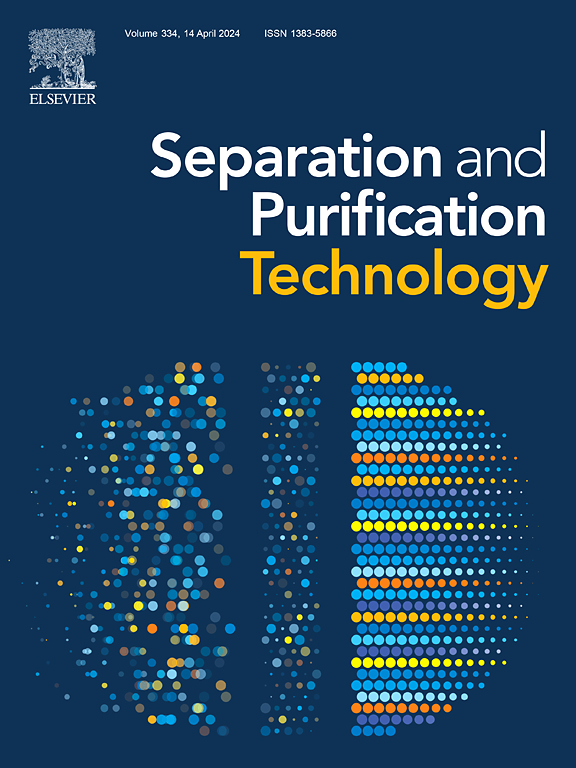Highly efficient photocatalytic conversion of CO2 achieved by constructing core–shell Z-scheme Bi2MoO6@COF heterojunction
IF 8.1
1区 工程技术
Q1 ENGINEERING, CHEMICAL
引用次数: 0
Abstract
The conversion of CO2 into hydrocarbon fuels through photocatalytic technology contributes to a sustainable carbon cycle. However, the use of noble metals and photosensitizers in previous studies has raised costs while the slow charge transfer rates during the photocatalytic process have diminished CO2 conversion efficiency. Therefore, this study investigated a core–shell Bi2MoO6@COF photocatalyst constructed by combining Bi2MoO6 nanoflower balls with the organic covalent framework TpPa-2-COF, which facilitated the photocatalytic reduction of CO2 under water vapor conditions. Additionally, the Z-scheme heterojunction formed between Bi2MoO6 and TpPa-2-COF promoted interfacial charge transfer, enhancing the separation efficiency of electrons and holes. The optimized Bi2MoO6@COF photocatalyst exhibited excellent catalytic performance in CO2 reduction reactions, achieving a CO reduction rate of 12.71 μmol·g−1·h−1 and a CH4 reduction rate of 5.5 μmol·g−1·h−1, which were approximately 2.73 times and 1.42 times higher than those of Bi2MoO6, respectively. Furthermore, the active species capture experiment, electron paramagnetic resonance (EPR) and photoelectrochemical techniques were employed to propose the photocatalytic mechanism of CO2 reduction for as-prepared Z-scheme Bi2MoO6@COF heterojunction.


通过构建核壳 Z 型 Bi2MoO6@COF 异质结实现二氧化碳的高效光催化转化
通过光催化技术将二氧化碳转化为碳氢化合物燃料有助于实现可持续的碳循环。然而,以往研究中贵金属和光敏剂的使用提高了成本,而光催化过程中缓慢的电荷转移速率降低了二氧化碳的转化效率。因此,本研究通过将 Bi2MoO6 纳米花球与有机共价框架 TpPa-2-COF 结合,研究了一种核壳 Bi2MoO6@COF 光催化剂,该催化剂可促进水蒸气条件下 CO2 的光催化还原。此外,Bi2MoO6 和 TpPa-2-COF 之间形成的 Z 型异质结促进了界面电荷转移,提高了电子和空穴的分离效率。优化后的 Bi2MoO6@COF 光催化剂在 CO2 还原反应中表现出优异的催化性能,实现了 12.71 μmol-g-1-h-1 的 CO 还原率和 5.5 μmol-g-1-h-1 的 CH4 还原率,分别是 Bi2MoO6 的约 2.73 倍和 1.42 倍。此外,利用活性物种捕获实验、电子顺磁共振(EPR)和光电化学技术,提出了制备的 Z 型 Bi2MoO6@COF 异质结的 CO2 还原光催化机理。
本文章由计算机程序翻译,如有差异,请以英文原文为准。
求助全文
约1分钟内获得全文
求助全文
来源期刊

Separation and Purification Technology
工程技术-工程:化工
CiteScore
14.00
自引率
12.80%
发文量
2347
审稿时长
43 days
期刊介绍:
Separation and Purification Technology is a premier journal committed to sharing innovative methods for separation and purification in chemical and environmental engineering, encompassing both homogeneous solutions and heterogeneous mixtures. Our scope includes the separation and/or purification of liquids, vapors, and gases, as well as carbon capture and separation techniques. However, it's important to note that methods solely intended for analytical purposes are not within the scope of the journal. Additionally, disciplines such as soil science, polymer science, and metallurgy fall outside the purview of Separation and Purification Technology. Join us in advancing the field of separation and purification methods for sustainable solutions in chemical and environmental engineering.
 求助内容:
求助内容: 应助结果提醒方式:
应助结果提醒方式:


